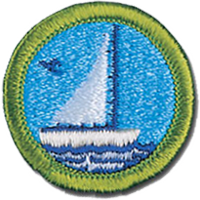Small-Boat Sailing


Resources
- Small-Boat Sailing Merit Badge Pamphlet
- Small-Boat Sailing Merit Badge Class Preparation Page
- Small-Boat Sailing Merit Badge Workbook
- Scoutmaster Bucky's Merit Badge Advancement Quick Reference
- Scoutmaster Bucky's Acknowledgement Form
Related
Small-Boat Sailing Requirements
Current Scouts BSA requirements
as of December 6, 2025
as of December 6, 2025
1.
Do the following:
a.
Explain to your counselor the most likely hazards you may encounter
while participating in small-boat sailing activities, and what you
should do to anticipate, help prevent, mitigate, and respond to
these hazards.
b.
Review prevention, symptoms, and first-aid treatment for the following
injuries or illnesses that can occur while sailing: blisters,
cold-water shock and hypothermia, dehydration, heat-related illnesses,
sunburn, sprains, and strains.
c.
Discuss the Scouting America Safety Afloat policy. Tell how it applies
to small-boat sailing activities.
2.
Before doing the following requirements, successfully complete the Scouting
America swimmer test.
3.
Describe the boat you will be using for the sailing requirement, naming all
of the major parts and the function of those parts.
Note: The skills may be demonstrated on any boat available to the
Scout; sailboards are not acceptable. While no specific sail plan is
recommended, it is suggested that the craft be smaller than 20 feet. The
boat must be capsizable and have the capability of sailing to windward.
4.
Before going afloat, do the following:
a.
Discuss the nine points of the Scouting America Safety Afloat plan.
b.
Explain the rules of the road in general and any specific rules or laws
that apply to your area or state.
c.
Explain how water conditions, the hazards of weather, and heavy winds
can affect both safety and performance in sailing.
d.
Discuss the warning signs of inclement weather and what to do should
heavy winds develop or a storm approach.
e.
Prepare a typical float plan.
f.
Discuss the proper clothing, footwear, and personal gear required for
small-boat sailing in warm weather and in cool weather. Explain how
choosing the proper clothing, footwear, and personal gear will help
keep you comfortable and safe while sailing.
5.
Discuss with your counselor how to identify the wind direction and wind
indicators. Explain the importance of this task before setting sail.
6.
Following the Scouting America Safety Afloat plan, show that you and a
buddy can sail a boat properly. Do the following:
a.
Prepare a boat for sailing, including a safety inspection.
b.
Get underway from a dock, mooring, or beach.
c.
Properly set sails for a round-trip course approved by your counselor
that will include running, beating, and reaching-the basic points of
sail. While sailing, demonstrate good helmsmanship skills.
d.
Change direction by tacking; change direction by jibing.
e.
Demonstrate getting out of irons.
f.
Demonstrate the safety position.
g.
Demonstrate capsize procedures and the rescue of a person overboard.
Note: Capsize procedures should be conducted under the close
supervision of the counselor. A rescue boat should be standing by to
assist, if necessary, and to tow the capsized craft to shore.
Self-bailing boats are acceptable for this requirement. Extreme care
should be taken to avoid personal injury and damage to the boat or
equipment.
h.
Demonstrate the procedure to take after running aground.
i.
Accept a single line or side tow and maneuver the craft being towed
safely for 20 boat lengths.
j.
Upon returning to the dock, mooring, or beach, properly secure all
equipment, furl or stow sails, and prepare the craft for unattended
docking or beaching overnight or longer.
7.
Demonstrate a working knowledge of marlinespike seamanship. Do the
following:
a.
Show how to tie a square (reef) knot, clove hitch, two half hitches,
bowline, cleat hitch, and figure-eight knot. Demonstrate the use of
each.
b.
Show how to heave a line, coil a line, and fake down a line.
c.
Discuss the kinds of lines used on sailboats and the types of fibers
used in their manufacture. Explain the advantages and disadvantages of
each.
8.
Describe how you would care for and maintain a sailboat and its gear
throughout the year.
9.
With your counselor, review sailing terminology and the points of sail.
Discuss various types of sailboats in use today and explain their
differences.